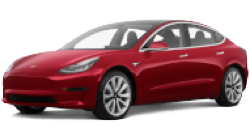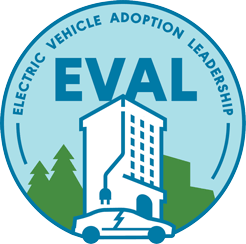Contents
- Why consider an EV?
- What is an EV?
- How do I charge an EV?
- What does an EV look like?
- I'm interested! Where do I start?
- Other Resources
Why consider an EV?
It’s a performance vehicle that will save you money.
Benefits
- Instant torque allowing you to quickly speed up and merge onto the freeway
- $1.24 per eGallon (U.S. Average)
- Latest technology such as driver assist lane tracking, emergency braking, and over-the-air updates
- Less maintenance
- Safer. EVs are ten times less likely to catch fire than conventional cars
- And, of course, they’re better for the environment, even when accounting for their manufacturing carbon emissions and when using electricity from coal plants.
Attend a National Drive Electric Week event to learn more.
What is an EV?
An electric vehicle is any vehicle that can drive on electricity derived from a power plug. An all-electric vehicle (sometimes called a battery electric vehicle or BEV) drives solely on power from the plug.
A plug-in hybrid electric vehicle (PHEV) is a car that can take both electricity (from plugging in) and gasoline. Usually, they run on electricity first and then draw on gasoline later. That way, you are driving electric around town and only use gasoline for long trips.
Plug-in vehicles offer a quiet, smooth and powerful ride. An electric motor provides full torque from a standstill and completely changes the experience of getting onto a fast-moving highway. Watch the following video for a taste of driving electric.
Attend a National Drive Electric Week event to learn more.
How do I charge an EV?
Most people recharge overnight in their garage, carport, driveway or work to meet their daily driving needs. There are also many public chargers for longer trips and other exceptional circumstances.
There are many ways to find public chargers, including PlugShare, which helps you find the charging station that works for your vehicle.
Attend a National Drive Electric Week event to learn more.
What does an EV look like?
EVs look like any other car. They come in all shapes and sizes, as you can see in the few examples below.
To see all EVs available in your state, visit PlugStar.com.
All-Electric EVs

Tesla Model 3
263-353 miles per charge
Chevrolet Bolt EV
259 miles per charge
Hyundai Kona Electric
258 miles per charge

Kia Niro EV
239 miles per charge
Jaguar I-PACE
234 miles per charge
Nissan LEAF
150-226 miles per charge
Plug-in Hybrid EVs (electric + gas)

Honda Clarity Plug-In
48 miles per charge
Toyota RAV4 Prime
42 miles per charge
Chrysler Pacifica Hybrid
32 miles per charge
Attend a National Drive Electric Week event to learn more.
I'm interested! Where do I start?
It’s time to test drive one! You know the basics, so now comes the fun part of browsing vehicles, test driving the ones you like, and finding how many purchase incentives are available in your area.
First, attend a National Drive Electric Week event near you to connect with your local EV community.
- Talk to real EV owners
- Attend an online or safe, in-person event
- Watch an EV parade
- Watch virtual test drives
Visit PlugStar.com to browse current models for sale, discover cost savings, and connect with EV certified dealerships.
You can also check out additional resources below to learn more about EVs.
- Browse Plug In America’s EV Guide for a quick overview of EVs for sale in dealerships
- Use Sierra Club’s Electric Vehicle Guide
- Schedule a safe, in-person test drive with your local dealership
Other Resources
Impact Overview: NDEW 2024
See below for information from our sponsors and social media.
Sponsor Materials
- Plug In America EV Guide
- Electric Vehicle Association
- Sierra Club Consumer Guide
- DriveElectricUSA Charging Tips
- DriveElectricUSA Organization Info
- EVHybridNoire
- Edison International English/Spanish Bilingual EV Rebate Flyer (CA only)
- Electric Vehicle Adoption Leadership Program Info
Social Media
Follow @DriveElecEvents on Facebook and Twitter. Find sample EV posts and hashtags in our social media guide.









